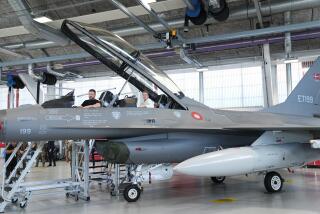NATO-Speak Adding to Crash Confusion
BRUSSELS — Yugoslav antiaircraft gunners have succeeded in shooting down two U.S. planes since Operation Allied Force began. Or should that be one, or none?
In a case of confusion that epitomizes some of the black holes in the Western alliance’s information strategy during its campaign against Yugoslavia, NATO and the Pentagon--and even two alliance generals--haven’t been able to agree about what led to the loss of two U.S. Air Force fighters, an F-117A Stealth and an F-16 Fighting Falcon.
In both instances, the pilots were rescued from Yugoslav territory by search teams within hours of being downed.
Gen. Klaus Naumann of Germany, NATO’s highest-ranking military officer and chairman of its Military Committee, told a news conference Tuesday that the two planes had been victims of enemy fire. Asked by a reporter to repeat that assertion, Naumann did so, saying he thought the information had already been announced.
It hadn’t been. On Thursday, North Atlantic Treaty Organization spokesman Maj. Gen. Walter Yertz of the German air force was asked if what Naumann had said was correct. Yertz replied: “I can’t confirm it.”
Meanwhile, a Pentagon spokesman Thursday was equally tight-lipped about the crash of the F-16. Pentagon officials, in fact, are being purposely imprecise about what brought down the jet early Sunday.
U.S. Air Force Maj. Gen. Charles Wald, a senior planner at the Joint Chiefs of Staff, said in a recent briefing that the plane crashed as a result of engine failure, but he declined to specify what caused the problem.
Other Defense Department officials said the Pentagon wants to be vague so Yugoslav forces aren’t sure whether their air-defense tactics are working. This information could be useful to them, according to this line of reasoning.
At the same time, Defense Department officials don’t rule out the possibility that the F-16 was shot down.
The Pentagon has followed a similar approach with the March 27 crash of the F-117A fighter.
While some Pentagon officials have acknowledged that the Stealth fighter was struck by a Soviet-designed surface-to-air missile, other officials have refused to say that was the case. Wald told reporters several weeks ago: “We know and we’re not going to tell you.”
According to an article in Aviation Week, the Stealth--supposedly virtually invisible to radar--was detected and hit by Yugoslav antiaircraft missile batteries because numerous errors were made. The article indicated that the pilot had followed the route flown by other F-117s and had left his bomb bay doors open longer than necessary, making the plane more visible on Yugoslav radar.
Dahlburg reported from Brussels and Richter from Washington.
More to Read
Sign up for Essential California
The most important California stories and recommendations in your inbox every morning.
You may occasionally receive promotional content from the Los Angeles Times.











